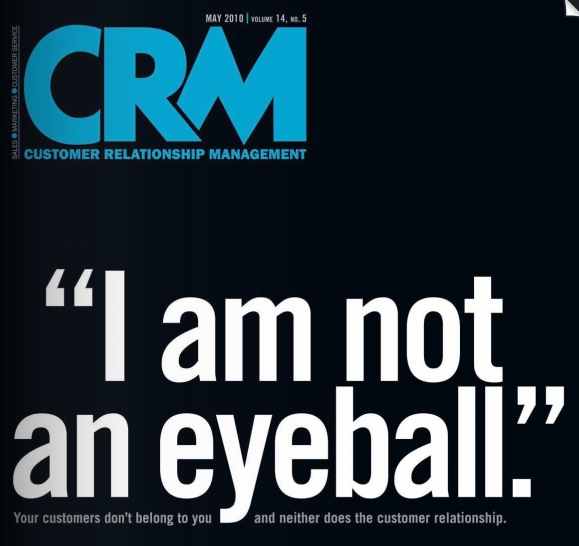Four years and a few months ago, CRM Magazine devoted much of its May issue to VRM. That’s the cover there on the right. It was way ahead of its time. Same goes for ProjectVRM, which started four years earlier.
That’s the cover there on the right. It was way ahead of its time. Same goes for ProjectVRM, which started four years earlier.
Now things are starting to shift.
I’ve heard encouraging reports from friends who went to Oracle OpenWorld last month and are headed to Salesforce‘s Dreamforce next week. They tell me it is now becoming apparent to CRM that it needs a hand to shake on the customer side that’s not a captive one. Specifically —
- That customers need scale across the many companies they deal with, just as companies need scale across the many customers they deal with. So, for example…
- A customer should to be able to change his or her address (plus other form fields) for every company they deal with in one move, rather than one at a time within each company’s separate CRM system.
- A customer should be able to intentcast as a qualified lead, safely and (at least at first) anonymously, outside of any one company’s captive marketplace.
- An individual’s sovereign identity matters more to them — and to the marketplace — than any administrative identities conferred by companies or governments.
- The negative externalities of unwelcome surveillance tend to outweigh whatever positive internalities the practice provides.
- Co-creating the customer experience is better than having one side in charge of the whole thing — especially when the customer has few ways to bring consistency to her experience with many different companies.
- Customers should have clouds of their own (aka personal clouds, stores, vaults, PIMS), and not just those of silo’d services.
- Customers need ways to express their own policies, preferences, terms and conditions, and not be forced all the time to accept those provided by sellers — and that mutually agreeable terms will be far better than the one-sided (and in many cases unenforceable) ones nobody reads because there’s no point to it.
- There is far more leverage on customer retention in the “own cycle” than in the “buy cycle” of the customer experience.
Speaking of which, here’s how that cycle looks, thanks to Esteban Kolsky, who drew the original: 
There are now many dozens of developers in or near the VRM space that can be helpful for CRM as well.
Given all the action that’s going on, it would be way cool if we can get players on both sides together in one room to talk and whiteboard our way onto common ground and build new and better stuff there.
So we’re in luck, because that’s what we have with VRM Day and IIW, both at the Computer History Museum in downtown Silicon Valley (101 and Shoreline Road in Mountain View), on the last week of this month.
- VRM Day is Monday, October 27.
- IIW (Internet Identity Workshop) is Tuesday to Thursday, October 28-30.
The two go together. VRM Day is located and timed to lead in to IIW. The topics are ones we’ll want to be working on for the next three days — and beyond.
IIW is an unconference. There are no speakers or panels. All the topics are vetted by participants, who lead discussions and push topics forward in breakout rooms. It’s designed that way so stuff gets done and not only talked about.
While the original focus was (and remains) identity, the workshop is open to anything. High on the list of topics that get worked on, every time, are VRM ones like those listed above.
VRM Day and IIW will provide an ideal week for anybody who wants CRM to truly engage customers to get together and help make that happen.
VRM developers need to know more about how to connect with and help CRM systems and related ones, such as sCRM (social CRM), Customer Experience Management and call centers.
CRM developers need to know more about how to connect with and help VRM developers.
And, since everybody with a wallet is also a customer, that character will be well-represented too.
So I encourage everybody involved in CRM or VRM to come to VRM Day and IIW — with a special shout-out to Oracle, SAP, Microsoft Dynamics, IBM, Salesforce and SugarCRM. We need you there. And so do you. 🙂
It’s time to make good on the promise we’ve seen coming for way too long.

 They
They